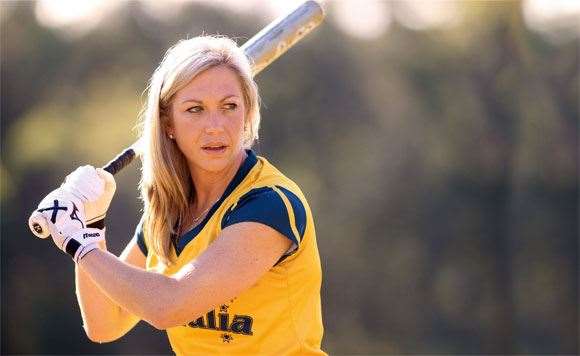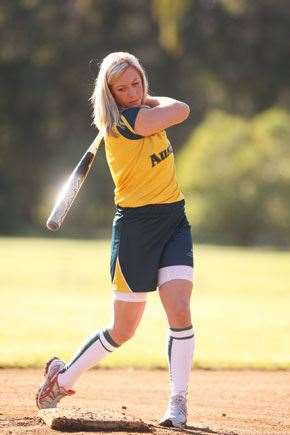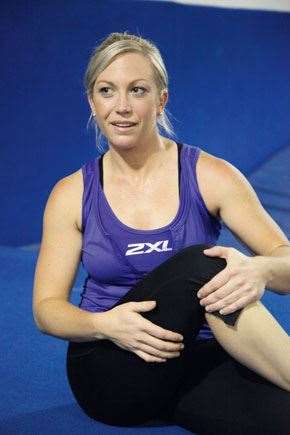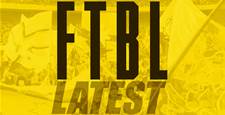The times are lean for women’s softball - the IOC voted to drop the sport from the Olympic program.
The times are lean for women’s softball – the IOC voted to drop the sport from the Olympic program.
 Australia Won bronze at Beijing
Australia Won bronze at BeijingImages: Duane Hart Sporting Images
A “Back Softball” campaign, headed by the Australian hitter Danielle Stewart, was promptly organised. The girls lobbied tirelessly to have their sport reinstated for the 2016 Games (“It was a task that was very close to my heart,” says Stewart. “All of last year was spent on the road.”) But in the end it was wasted energy – golf and rugby were given the nod. “The next push will be for 2020,” says Stewart. But there’s a weariness in her voice: “It’s so far off.”
In Australia, it’s a body blow the sport can scarcely afford to take. Already the girls were operating on a shoestring budget – now the shoestring’s been snatched away altogether. Media attention has dried up, sponsorship dollars have evaporated. Without Olympic funding from the Federal government, the girls now have to pay their own way to every tournament. It’s taken a toll – of the 15 girls who won bronze in Beijing, just six will travel to Caracas this month for the World Championships.
And one of those six will be Stewart. A noted hitter who has now racked-up over 150 games for the Aussie Spirit, she hopes to slug her sport back into the Australian consciousness with World Championship gold. Here’s the program that will get her there.
Changing Times
Our gym work of late has been very different to what I’ve previously been exposed to. We used to do lots of short, sharp movements – lots of jumping and bounding. Over the past six months, however, we’ve had a new coach come on board – Jeremy Shepherd, the AIS strength coach – so we’ve gone into a different phase of lifting. Personally, I’ve benefitted a lot. I’ve noticed my core strength has improved and that’s really transferred to my hitting.
We do all these workouts in four-week blocks with the reps and sets varying each week. After a month, we switch programs. Ideally, we want to be lifting three times a week, but because we’re approaching the world champs we’re only doing two sessions. It’s still our responsibility, however, to do a lighter third session on our own time.
Building Bulk
At the moment we have two solid weights sessions a week. In the warm-up stage we’ll start off with a snatch squat and dumbbell overhead walks. As warm-ups, these movements are meant to be very smooth, very controlled. After that, we move into the maximum power and strength section. Typically we’ll start this section with a front squat. We generally do three to five sets with reps varying between three to six. Rest in between sets is no more than a minute. From there we’ll move on to a dumbbell lunge. With this exercise the reps are higher, the sets lower – normally two to four sets of around ten reps. After that we do dumbbell bench, then a wide-grip seated row. These exercises are good because they break up the heavier leg work.
Having done this heavy workout, we then move into one of four different circuits. For example, we’ll do a shoulder circuit. This begins with medicine ball throws where we take a 2kg med ball and hurl it against a wall to replicate the throwing dynamics. After that we’ll take a med ball that’s connected to a rope and swing it against a wall to replicate the swing motion. We’ll then move to a seated row and lying dumbbell rotations for our shoulder blades. We’re not pushing large weights – all these exercises are done in sets of ten reps with the weight between three to five kilos. We’ll then finish the shoulder circuit with a “dumbbell combo” that includes bentover flys, dumbbell raises and side raises, all in continuous sets, so it’s a real cardio workout. We’ll normally do two repetitions of the circuit. After that we finish with a specific trunk circuit – we have four ab exercises that we repeat four times.
 “If I have a week or two off, I feel my abs are the first thing to go."
“If I have a week or two off, I feel my abs are the first thing to go."Images: Duane Hart Sporting Images
Keep It Flexible
Before every session we have 15 minutes for general warm-up stretches. I’ll normally do a lot of ITB work on those rollers. I also like to work any pressure points with massage balls – just to work out any tension from previous sessions.After weights we then do another 15 minutes of stretching where we focus on our quads, our hip flexors and – particularly – our backs. When you’re doing a lot of lifting and then backing that up with hitting, your back muscles really feel it. That’s why we’re putting such an emphasis on our core strength, doing these heavy squats and lunges. A strong core really relieves the strain on your back.
To A Tee
I always start a hitting session with a warm-up on the tee – hitting a stationary ball into a net. Using the tee I’ll work through different locations on the plate. There are nine different zones on the plate – imagine a noughts-and-crosses grid – and I’ll work my swing from inside-low right up to outside-high. If I do ten strikes in each of those locations, I’m satisfied that has taken me through all nine areas of the strike zone. I can also add more variety to that by raising and lowering the level of the tee.
The tee is great because it really highlights any flaws in your swing. You know where, say, an inside-low pitch should go; you know where that ball should hit the net. Ideally if you receive an inside pitch you should be hitting it to left field, if you receive an outside-high pitch you should be hitting it to right field. If the ball doesn’t hit that spot on the net then there’s a flaw in your swing. The tee is great for giving you immediate results; it means you don’t waste your bats when you’re in front of a live pitcher.
Staying on the tee, I’ll then usually work some hits straight up the middle, line drives. I’ll be aiming for a target around waist-height, middle of the net. The focus here is on my extension. If my swing is technically in sync – I’m balanced, I’m extending through the ball – then I should be hitting that target every single time. Of course that doesn’t happen! But it’s a good hitting routine you can do on your own that gives you immediate feedback on your swing.
Watch It Live
With live pitching we normally start with a front toss, where the pitcher is standing about four metres in front of you throwing the ball through a hole in a net. Obviously they’re not pitching the full motion. This is a good warm-up to receiving live pitching.
With live pitching we can hit off our team- mates if they’re available – of course that’s a pitching workout for them, too. We normally have a catcher involved as well, because you want to make it as game-like as possible. The problem at the moment is that, with our world champs team, there are only two other girls in Queensland at the moment, so it’s hard to get enough quality live pitching. A lot of the girls are over in Japan or Italy, playing in professional leagues, so we’re all very dispersed. That’s why most of our training is either individualised or done in small groups. This makes it hard to recreate game situations.
Occasionally we’ll hire a men’s pitcher to come out and pitch to us. This is good because they throw it harder and faster than a female does, so it’s really good practice for us. Having faced top-quality men’s pitching, when we go to the world champs and face, for example, the USA, we’ve seen that movement, that speed before. Having said that, we don’t have a high budget, plus we have to use men who are in our area, so we’re probably lucky to get live hitting against a male pitcher once a week.We also use pitching machines. They’re good for simulating the speed, but they don’t simulate the movement of a pitched ball. Still, it’s probably the next best option after live pitching.
 Danielle Stewart
Danielle StewartImages: Duane Hart Sporting Images
Video Games
Throughout our domestic competition, we’ve hired a video analyst who’s taped all the games and then put them in movie files for each player. At the end of each tournament she gives me a little USB stick that has all my bats on it. I then go back to our Australian coach – Fabian Barlow, fortunately he’s based in Brisbane – and he’ll work through the mechanics and technique of my swing. This is particularly something we do earlier in the season. Now that the world champs are approaching it’s not the time where we want to be worrying about technique – we just want repetition, getting at bat, getting at bat ...
Homework
Just as we tape our own batters, we obviously tape the opposition pitchers as well. From these clips I’ll take note of the pitchers’ patterns, their signals, what they like to throw to me. Take the USA, for example. Their pitching staff is the best in the world and typically they’ll pitch to their strengths. They don’t show flexibility for individual players – they’ll continue pitching to their strength. They’ve been so successful with that they haven’t had to develop game plans for individual hitters. Personally, I want to have a game plan for each pitcher.
We can also put these clips up on a big screen and then stand in front of it and watch their action, mimic our own swing, get familiar with seeing them front-on. Most pitchers have some sort of tendencies – a certain grip on the ball, for example, or holding the ball in a certain part of their glove – and we really try to learn these tendencies so we have some idea of the pitch we’re likely to receive. You’ve got to have a notebook – this knowledge bank is crucial.
We’ve learnt from men’s softball – the Australian men recently won the world championships and they said they knew they were going to win because they had everything planned. They knew exactly what they were going to receive from different pitchers, different batters. They had it all calculated out. If plan A didn’t work, they had a plan B. The key to their success was doing their homework. That’s become our plan, too.
Learning To Fail
If you hit three out of ten and get a batting average of .300 you’re a superstar – so how do you get used to failing seven times? It’s just exposure – the more you play, the more you get used to it. You have to be willing to fail. Besides,
a lot of the time it just comes down to luck. You can hit a fantastic ball but someone can take a diving catch. You’ve got to accept that luck plays a big part in this sport.
Personally, I find a good way of dealing with this is having the same routine, the same approach, every time I go to the batter’s box. I have seven steps from the dugout to the plate – watching the pitcher, see if they’re hitting their spots, understand the umpire’s zone etc – and I follow these steps every time I go to bat. When I’m at the plate I don’t want to be thinking about anything technical. I just have a single keyword in my head – normally that’s “explode”. When you’re in the batter’s box all you want to be thinking is: see the ball, hit the ball, breathe.
And, of course, after each pitch you’ve got time to review what just happened. You’ve got to be honest with yourself, but you’ve also got to let it go. You get three to four at-bats a game and then you’ve got to move on and field. Your situation’s constantly changing, so you can’t get stuck on one moment – you have to be resilient.
– Aaron Scott
Related Articles

19 Holes With ... Chad Townsend and Val Holmes













